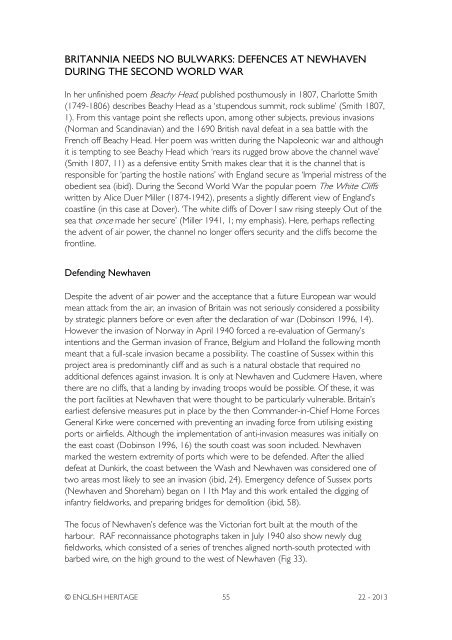Aerial Investigation and Mapping Report - English Heritage
Aerial Investigation and Mapping Report - English Heritage
Aerial Investigation and Mapping Report - English Heritage
You also want an ePaper? Increase the reach of your titles
YUMPU automatically turns print PDFs into web optimized ePapers that Google loves.
BRITANNIA NEEDS NO BULWARKS: DEFENCES AT NEWHAVENDURING THE SECOND WORLD WARIn her unfinished poem Beachy Head, published posthumously in 1807, Charlotte Smith(1749-1806) describes Beachy Head as a ‘stupendous summit, rock sublime’ (Smith 1807,1). From this vantage point she reflects upon, among other subjects, previous invasions(Norman <strong>and</strong> Sc<strong>and</strong>inavian) <strong>and</strong> the 1690 British naval defeat in a sea battle with theFrench off Beachy Head. Her poem was written during the Napoleonic war <strong>and</strong> althoughit is tempting to see Beachy Head which ‘rears its rugged brow above the channel wave’(Smith 1807, 11) as a defensive entity Smith makes clear that it is the channel that isresponsible for ‘parting the hostile nations’ with Engl<strong>and</strong> secure as ‘Imperial mistress of theobedient sea (ibid). During the Second World War the popular poem The White Cliffswritten by Alice Duer Miller (1874-1942), presents a slightly different view of Engl<strong>and</strong>’scoastline (in this case at Dover). ‘The white cliffs of Dover I saw rising steeply Out of thesea that once made her secure’ (Miller 1941, 1; my emphasis). Here, perhaps reflectingthe advent of air power, the channel no longer offers security <strong>and</strong> the cliffs become thefrontline.Defending NewhavenDespite the advent of air power <strong>and</strong> the acceptance that a future European war wouldmean attack from the air, an invasion of Britain was not seriously considered a possibilityby strategic planners before or even after the declaration of war (Dobinson 1996, 14).However the invasion of Norway in April 1940 forced a re-evaluation of Germany’sintentions <strong>and</strong> the German invasion of France, Belgium <strong>and</strong> Holl<strong>and</strong> the following monthmeant that a full-scale invasion became a possibility. The coastline of Sussex within thisproject area is predominantly cliff <strong>and</strong> as such is a natural obstacle that required noadditional defences against invasion. It is only at Newhaven <strong>and</strong> Cuckmere Haven, wherethere are no cliffs, that a l<strong>and</strong>ing by invading troops would be possible. Of these, it wasthe port facilities at Newhaven that were thought to be particularly vulnerable. Britain’searliest defensive measures put in place by the then Comm<strong>and</strong>er-in-Chief Home ForcesGeneral Kirke were concerned with preventing an invading force from utilising existingports or airfields. Although the implementation of anti-invasion measures was initially onthe east coast (Dobinson 1996, 16) the south coast was soon included. Newhavenmarked the western extremity of ports which were to be defended. After the allieddefeat at Dunkirk, the coast between the Wash <strong>and</strong> Newhaven was considered one oftwo areas most likely to see an invasion (ibid, 24). Emergency defence of Sussex ports(Newhaven <strong>and</strong> Shoreham) began on 11th May <strong>and</strong> this work entailed the digging ofinfantry fieldworks, <strong>and</strong> preparing bridges for demolition (ibid, 58).The focus of Newhaven’s defence was the Victorian fort built at the mouth of theharbour. RAF reconnaissance photographs taken in July 1940 also show newly dugfieldworks, which consisted of a series of trenches aligned north-south protected withbarbed wire, on the high ground to the west of Newhaven (Fig 33).© ENGLISH HERITAGE 55 22 - 2013

















